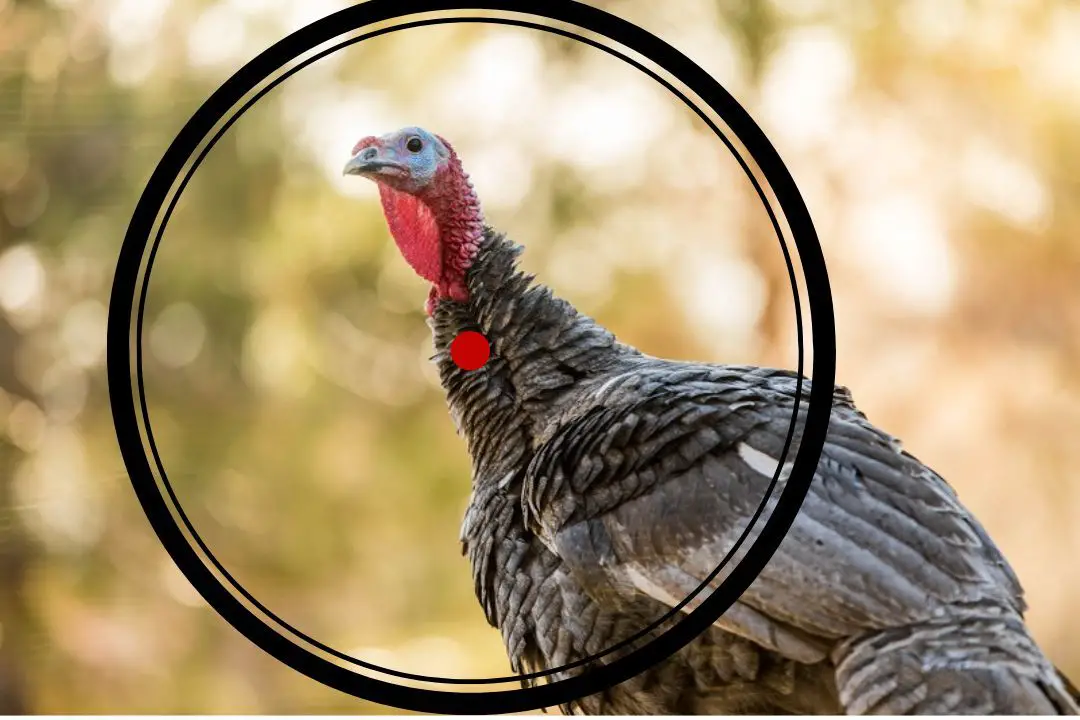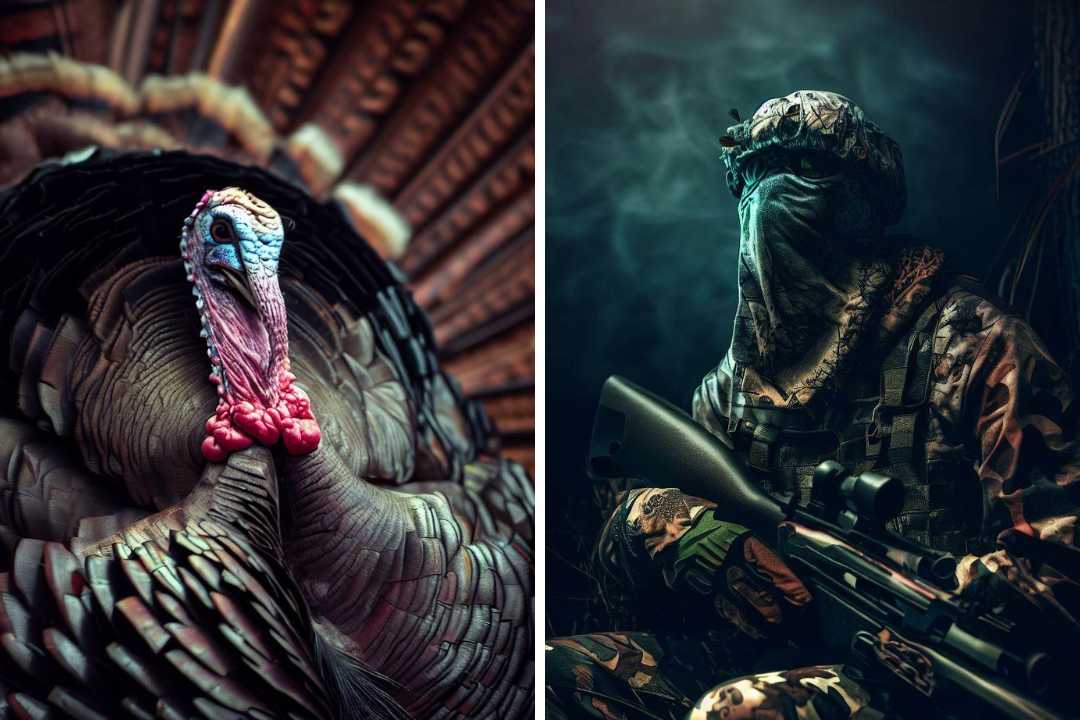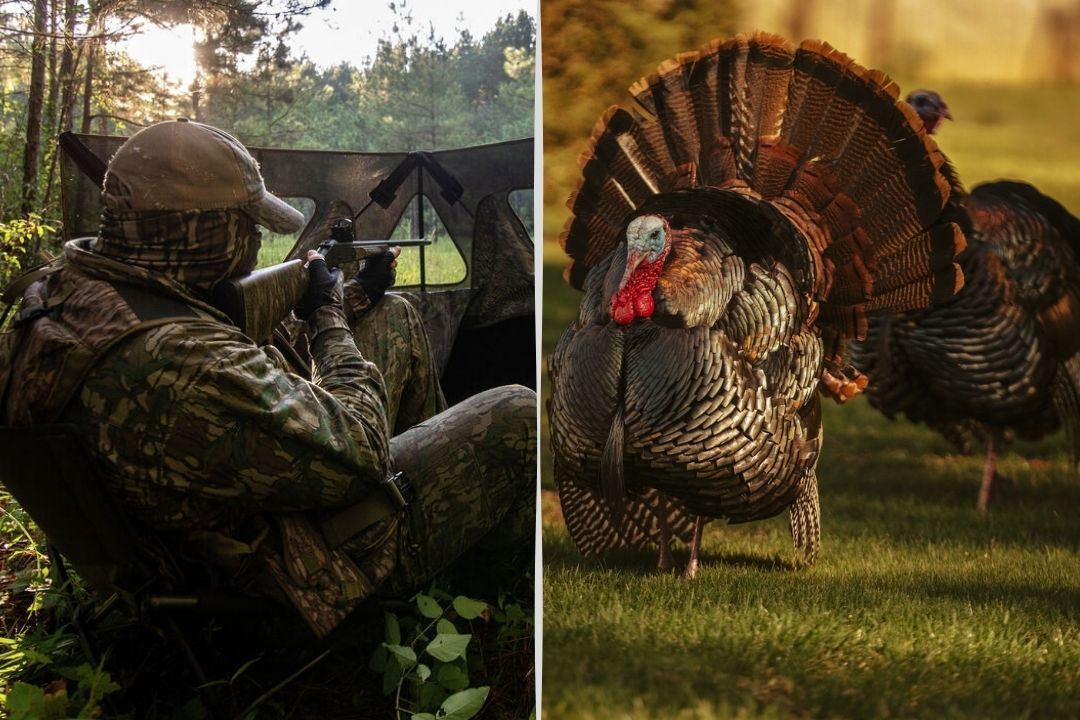Forget Fall Tactics: Why Spring Turkey Hunting Demands a New Mindset
Spring gobblers play by different rules. Unlock their secrets with our in-depth guide to calling, scouting, and spring-specific success. Read now!
Forget the predictable rhythms of fall hunts. Spring turkey hunting demands a different breed of hunter.
Gobblers haunted by hens require more than rote calls and textbook setups. Every encounter is a puzzle, forcing you to read their shifting moods and adapt on the fly.
This is where patience and strategy collide, where the thrill lies in outsmarting – not just outlasting – your quarry.
But how does one master this elusive game of strategy and instinct?
Understanding the season's distinct rules, from shifting gobbler behavior to the specialized tactics that bring them within range, is paramount to success.
Key Takeaways
→ The Gobbler's Mind: Decode the subtle shifts in spring gobbler behavior that can make or break your wild turkey hunt in spring.
→ Beyond Basic Calls: Learn the nuanced calling sequences that will lure in even the most wary toms.
→ Strategic Setups: Discover the secrets of spring-specific decoy placement and ambush tactics.
→ Mid-Day Advantage: Bust the myth that mornings are your only chance – understand how to capitalize on midday opportunities.
→ The Right Gear (Without the Excess): Cut through the clutter and focus on the essentials for a successful spring turkey hunt... but there's one often overlooked element that might surprise you.
Understanding the Fundamentals: Season Dates and Regulations
Just having your hunting license is not often enough. Before you lace up your boots or practice those yelps, understanding the rules of the spring game is paramount.
Hunting turkeys is heavily regulated, and those rules vary significantly between states. Think of this as your pre-hunt checklist, ensuring you're operating both legally and ethically.
Spring Turkey Hunting Season
- Your First Stop: Don't rely on general advice or last year's dates. Visit your state's wildlife agency website for the most up-to-date spring turkey season openings, closings, and any special youth or limited-draw hunts.
- Know Your Limits: Bag limits (how many gobblers you can harvest) are strictly enforced. Understand these limits before heading into the field.
Rules of Engagement
- Weapons & Restrictions: Many states are shotgun or archery only during spring seasons. Check if certain shotgun gauges, choke sizes, or archery equipment have specific regulations.
- Tagging & Reporting: Familiarize yourself with any tagging requirements upon harvesting a gobbler. Some states may require additional reporting.
Beyond a Turkey Permit: Taking the time to understand these fundamentals isn't just about avoiding fines; it demonstrates a respect for the resource and supports sustainable turkey populations.
States | Usual Start Date | Season Length (weeks) | Preferred Weapon | Known For | Resources |
Alabama | Mid- March | 5 | Shotgun/Archery | Excellent public land access | Alabama Dept. of Conservation & Natural Resources |
Missouri | Mid-April | 6 | Shotgun/Archery | Long season, good opportunity | Missouri Dept. of Conservation |
Pennsylvania | Early April | 5 | Shotgun | Strong hunting tradition | Pennsylvania Game Commission |
Georgia | Mid- March | 4 | Shotgun/Archery | Good distribution across the state | Georgia Dept. of Natural Resources |
Mississippi | Early April | 5-6 (zone dependent) | Shotgun/Archery | Often overlooked, good numbers | Mississippi Dept. of Wildlife, Fisheries, and Parks |
Wisconsin | Mid-April | 6 | Shotgun/Archery | Expanding range, increasing harvest | Wisconsin Dept. of Natural Resources |
Texas | March/ April (zone dependent) | 3-4 (zone dependent) | Shotgun/Archery/Muzzleloader | Multiple subspecies, vast lands | Texas Parks & Wildlife Dept. |
New York | Mid-April | 4 | Shotgun/Archery | Surprisingly strong population | New York State Dept. of Environmental Conservation |
Ohio | Late-April | 4 | Shotgun/Archery | Steady numbers, accessible hunting | Ohio Dept. of Natural Resources |
Kentucky | Mid-April | 4 | Shotgun/Archery | Good populations in certain regions | Kentucky Dept. of Fish & Wildlife Resources |
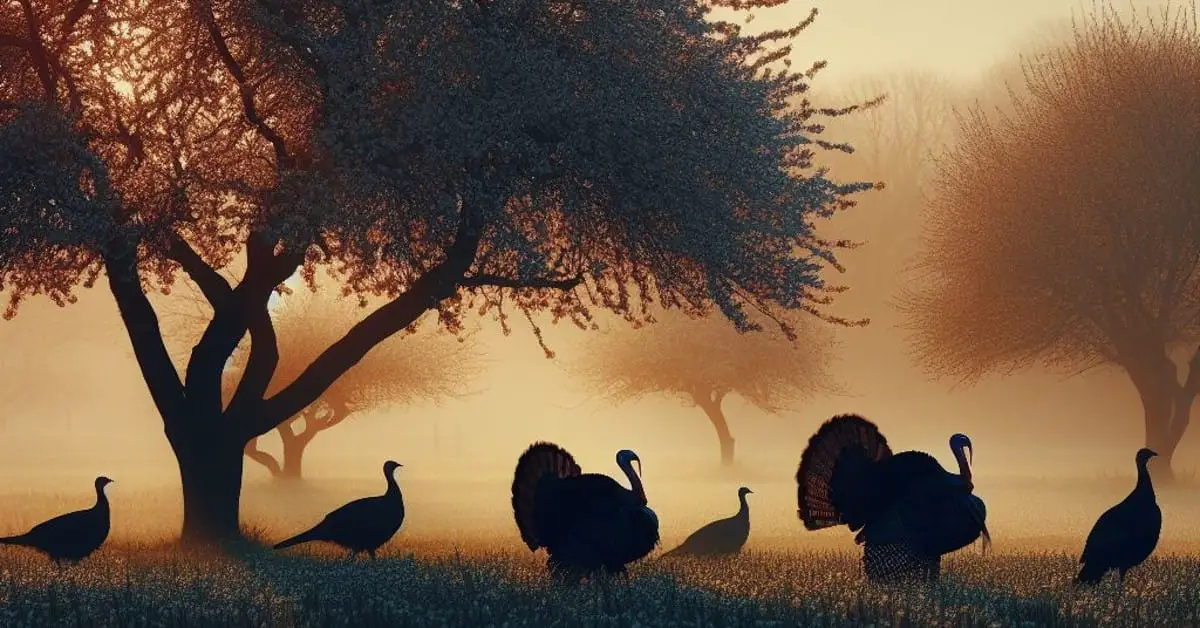
The Unique Challenge of Spring Turkey Season
Fall season hunts follow a certain predictability – gobblers flocking, responding readily to calls, more focused on feeding patterns. But spring throws a curveball.
A gobbler's world revolves around the breeding season, his attention laser-focused on hens. This shift in priorities forces the aspiring spring hunter to adapt – or go home empty-handed.
The seasoned strategist knows that success lies in understanding this fundamental shift. Standard calling sequences may fall flat. Textbook setups might leave you watching a gobbler strut away with his harem.
Mastering the nuances of spring turkey behavior is the key to unlocking those heart-pounding encounters unique to this adrenaline-fueled season.
Why General Turkey Hunting Knowledge Isn't Enough
Experience with other hunts provides a foundation, but the spring woods demand more. To consistently outsmart a lovestruck tom, you'll need to:
- Dissect the language of hens: Learn how to mimic not just basic yelps, but the subtle variations that influence a gobbler's decisions.
- Recognize the invisible boundaries: Discover how hens and gobblers use terrain during breeding season, influencing where you set up and how you approach.
- Become a master of patience: Frustration is your enemy in the spring. A seasoned hunter knows when to hold back, observe, and strike only when the odds are decisively in their favor.
Mastering the Basic Hen Language
Knowing a few basic yelps won't cut it in the spring. A wary gobbler can tell if your calls are flat imitations or the real deal – and he'll ignore you if they're not convincing. Think of hen vocalizations as a conversation, not just random noise. Here's where to start:
- The Yelp: This is the foundation of most calling sequences. But in the spring, subtleties matter. Master variations in pitch, volume, and rhythm to mimic everything from a contented hen to an agitated one.
- The Cluck and Purr: These close-range sounds communicate reassurance and contentment. They're essential for luring in a suspicious gobbler those final critical yards.
- The Cutting: This sharp, aggressive series of yelps can provoke a dominant hen...or a fired-up gobbler looking for a fight. Use it strategically, not randomly.
It's Not Just What You Say, It's How You Say It
Timing and inflection are critical in spring turkey hunting. A poorly timed call sequence can send a gobbler running the other way. Pay attention to these nuances:
- Cadence: Vary the spacing between calls to create a sense of urgency or laid-back disinterest.
- Emotion: Inject subtle inflections to mimic a hen that's eager, agitated, or simply going about her day.
- Realism: Even the most convincing sequence won't fool a gobbler if it lacks the natural pauses and imperfections of genuine hen chatter.
Calling Sequences for Typical Scenarios
| Scenario | Sequence | Goal | Additional Tips |
|---|---|---|---|
| Gobbler with Hens | Soft yelps & clucks, occasional purrs | Reassure hens, lure gobbler away | Less is more, mimic a content hen, avoid aggressive cutting |
| Lone Gobbler | Series of yelps, increasing in volume and/or urgency | Pique curiosity, mimic a searching hen | Mix in clucks and purrs for realism, pay attention to his response |
| No Response (Likely Roosting) | Loud fly-down cackle, followed by soft yelps & clucks | Simulate a hen leaving the roost, can trigger early gobbling | Use sparingly, don't 'educate' nearby birds if no response |
| Distant Gobbler, Seems Unresponsive | Occasional soft yelps and clucks | Project the image of an unpressured hen | Patience is key, he may silently close the distance, change calling location if no response after an hour |
| Gobbler Hangs Up (Close, but Not Closing) | Subtle yelps and purrs, mix in a few soft cuts | Mimic a feeding hen, or a mildly challenging rival | Vary cadence and volume, go silent to spark his search |
Mastering the Basic Hen Language (With a Springtime Twist)
A wary spring gobbler isn't fooled by generic calls. To consistently draw his attention, you need to mimic the nuanced conversations between hens and gobblers during the breeding season.
Here are a few go-to sequences:
The "Lost & Lonely" Sequence
- Scenario: A solo gobbler, no hens in sight. He's actively seeking companionship.
- The Calls: Start with a series of soft, intermittent yelps and clucks – a hen simply announcing her presence. Gradually increase the volume and urgency if he doesn't immediately respond.
- Goal: Pique his curiosity and lure him closer, searching for the source of the calls.
The "Challenge Cut"
- Scenario: A gobbler strutting with hens, seemingly uninterested in your calls.
- The Calls: Interrupt his contented clucking with a sharp, aggressive cutting sequence. This simulates a rival hen trying to steal his attention.
- Goal: Trigger his competitive instinct, hoping he'll break away from the hens to investigate the intruder.
The "Contentment Seduction"
- Scenario: A gobbler within sight, but he seems fixated on a real hen.
- The Calls: Focus on soft, reassuring purrs and clucks. Intersperse these with occasional soft yelps.
- Goal: Convince him there's another receptive hen nearby, offering a tempting alternative.
Remember:
→ Observe & Adapt:No sequence is foolproof. Watch the gobbler's reaction and adjust your calling accordingly.
→ Less is More: Overcalling in the spring is a common mistake. Sometimes, subtle sounds and strategic silence are your best weapons.
→ Practice Makes Perfect: Master these sequences before heading into the woods. Confidence in your calls translates to confidence in the field.
Now, let's see how you can use spring gobbler behavior to your advantage when choosing hunting locations and setups.
Decoding Strutting Zones and Seasonal Movements
Understanding where turkeys are likely to be, and why, is a game-changer in the spring. Forget the predictable feeding patterns of other seasons. Breeding behavior dictates their every move, and the savvy hunter must adapt accordingly.
Strutting Zones: The Epicenter of Spring Action
These open areas (fields, pastures, logging clearings) are where gobblers display, attracting hens and challenging rivals. Pinpointing them is key to your hunting strategy:
- The Early Bird: Gobblers often strut on high ground at first light. Glassing these areas from a distance can reveal their whereabouts.
- Shifting Locations: Toms may have multiple strut zones. Observe their patterns for a few days if possible, noting where they enter and exit these zones.
- The Invisible Boundary: Hens often lead gobblers to secluded nesting areas within a few hours of leaving the strut zone. Identifying nearby timber or thick cover can point you towards those midday hotspots.
Strut Zone Indicators
| Feature | Sign | Why It Matters | Scouting Tips |
|---|---|---|---|
| Open Fields | Tracks, droppings, feathers, dusted areas | High visibility for strutting, attracts hens | Look for entry/exit trails, feeding areas nearby |
| Logging Clearings | Scratched-up ground, strut drag marks, wingtip feathers | Offers display space, good insect foraging | Focus on edges near thicker cover for midday use |
| Fence Lines & Field Edges | Tracks, droppings, strut marks | Natural travel corridors, hens may feed nearby | Identify ambush points where gobbler might cross |
| Isolated Trees | Droppings concentrated beneath, feathers | Roosting sites, gobblers often strut nearby at dawn | Glass fields near roost trees pre-dawn |
| Water Sources | Tracks, muddy areas, droppings | Attracts both hens and gobblers, especially in dry weather | Look for travel routes between water and feeding areas |
Travel Corridors: Intercepting Gobblers on the Move
Turkeys don't stay put, especially in the spring. Learn to identify the routes they favor between strutting zones, feeding areas, and nesting sites:
- Funnel Points: Look for saddles in ridges, narrow strips of timber between fields, even well-worn logging roads. These are places gobblers are likely to pass through.
- The Power of Observation: Pre-season scouting can reveal these corridors. Look for tracks, droppings, and feathers to confirm turkey traffic.
- Ambush Tactics: Setting up strategically along a travel corridor can be more effective than trying to lure a gobbler away from his chosen route.
Next let's understand spring-specific decoy setups and how to use them to your advantage.
Decoy Strategies for Spring Season
Decoys can be powerful tools in the spring, but the "throw it out and hope" approach rarely works. Understanding gobbler psychology during breeding season is key to selecting the right setup and positioning it for maximum effect.
Less is Often More
While full strut decoys can be effective later in the season, early spring often calls for a minimalist approach:
- The Single Hen: This conveys a receptive hen, potentially luring a lonely gobbler or one seeking an easy conquest.
- Hen and Jake: This combo can trigger a dominant gobbler's aggression. The jake presents a non-threatening rival he's eager to chase off.
- Confidence Boost: Sometimes, a lone hen decoy simply reassures a gobbler that he's on the right track, encouraging him to close the distance.
Position is Everything
Where you place your decoys is as important as what you use. Consider these spring-specific tactics:
- Edge of the Action: Place decoys on the edge of strutting zones, not in the center. This forces the gobbler to commit before he sees the entire setup.
- Line of Sight: Position decoys where you'll have a clear shot, but slightly out of the gobbler's direct path. This encourages him to circle the decoy, offering better shot opportunities.
- Natural Cover: Use a small bush or natural terrain feature to partially obscure your decoy. This adds realism and can make a wary gobbler commit.
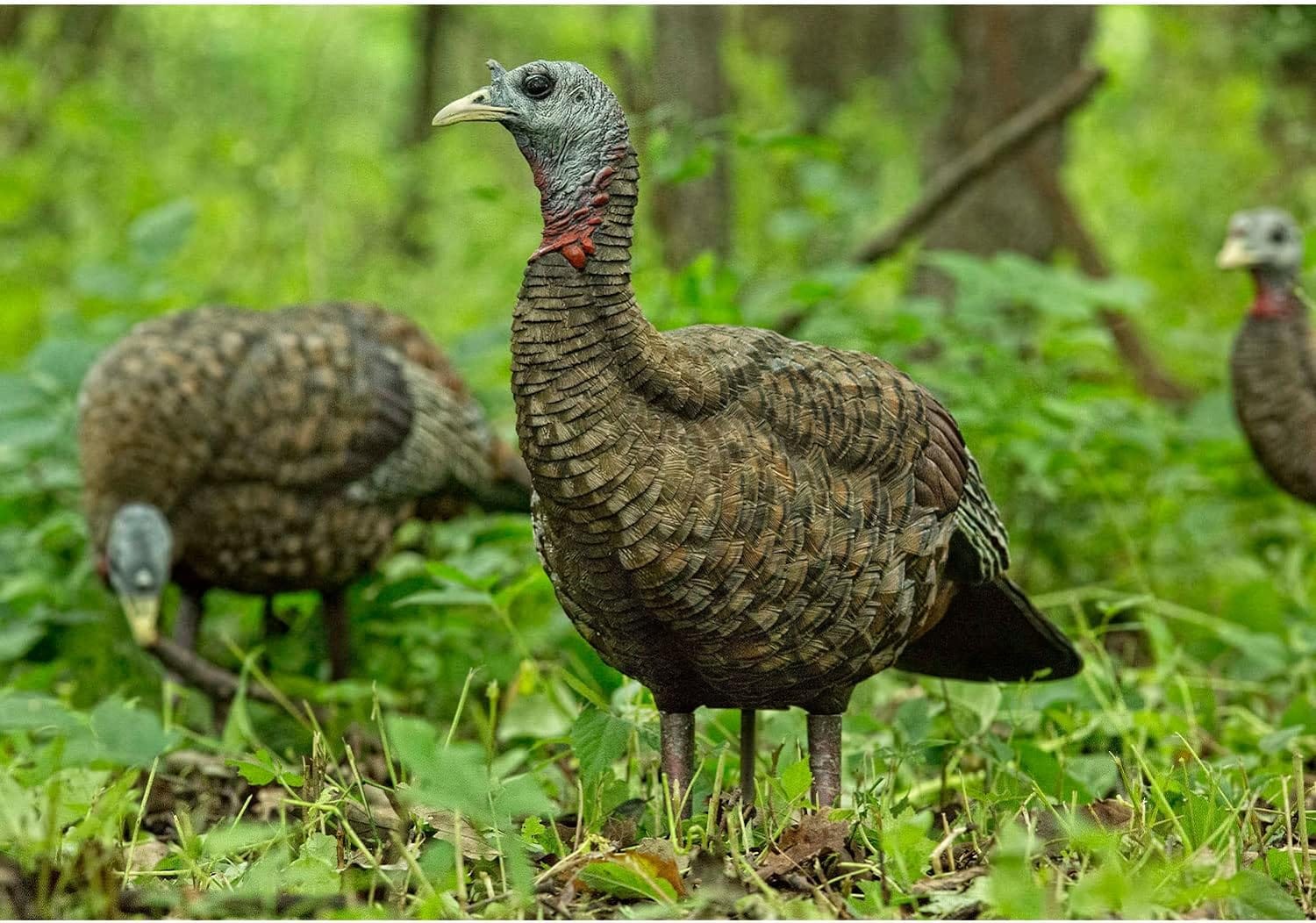
The Mid-Day Advantage: When Other Hunters Quit, You Succeed
Mornings get all the attention in turkey hunting, but savvy turkey hunters know that midday holds untapped potential in the spring. Gobblers abandoned by hens, or those simply taking a break from chasing females, become surprisingly responsive to the right tactics.
Where the Midday Gobblers Hide
When hens head to nesting areas mid-morning, gobblers often seek out these locations:
- Shady Retreats: Cool, shaded timber with leaf litter for feeding can attract gobblers looking to rest and refuel.
- Water Sources: Creeks, ponds, or even puddles become magnets for thirsty birds.
- Isolated Fields: A lone gobbler might continue strutting in a field, hoping to draw in a late-season hen.
Change Your Tactics
Midday success requires a shift in strategy. Think stealth and focused calling:
- Slow and Steady: Move quietly into likely midday spots, stopping frequently to listen for gobbles.
- Subtle Calling: Forget loud, aggressive sequences. Soft yelps and clucks can lure in a curious gobbler without spooking him.
- Patience is King: Be prepared to sit still and observant. A midday gobbler might appear out of nowhere.
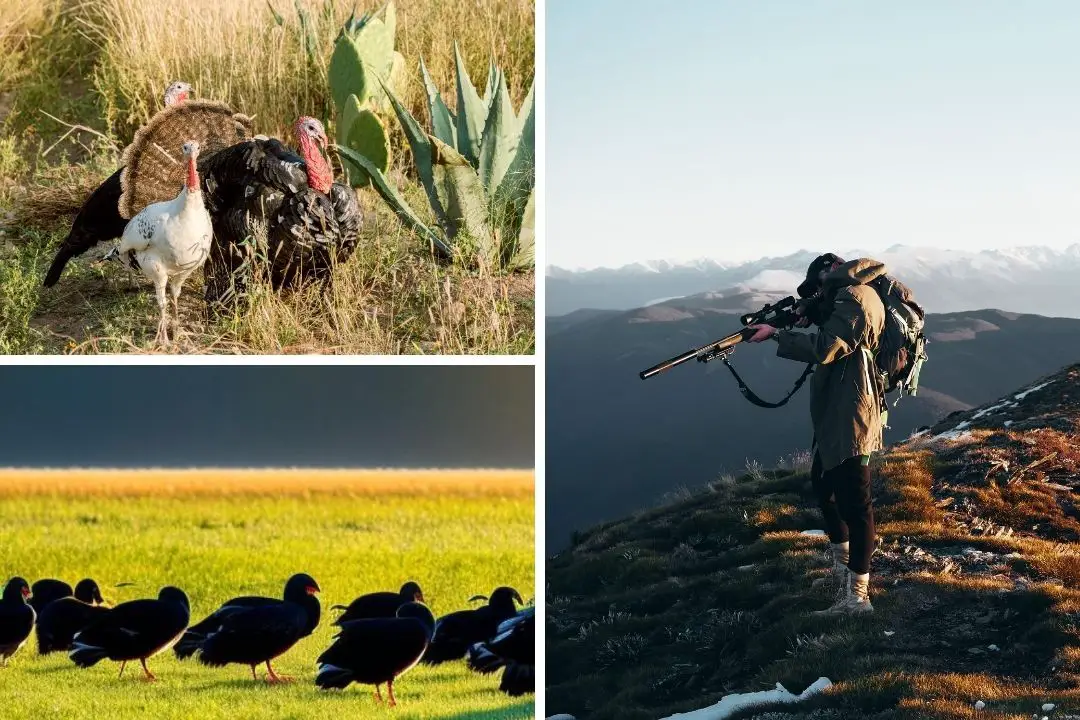
Remember:
→ Less is More: Overly aggressive or frequent calling can alarm a midday gobbler.
→ Adapt to His Response: Pay close attention to how the gobbler reacts and adjust your sequence accordingly.
→ Silence is Golden: Sometimes the best tactic is to stop calling altogether and let the gobbler think the hen has moved away. This can spark him to come searching.
Now, let's take a look at the essential turkey hunting gear choices that separate the well-prepared spring hunter from those struggling with the bare minimum.
Dressing for Success in the Spring
Spring weather is notoriously unpredictable. Layering is essential for comfort, allowing you to adapt to changing temperatures and stay focused on the hunt, not the elements.
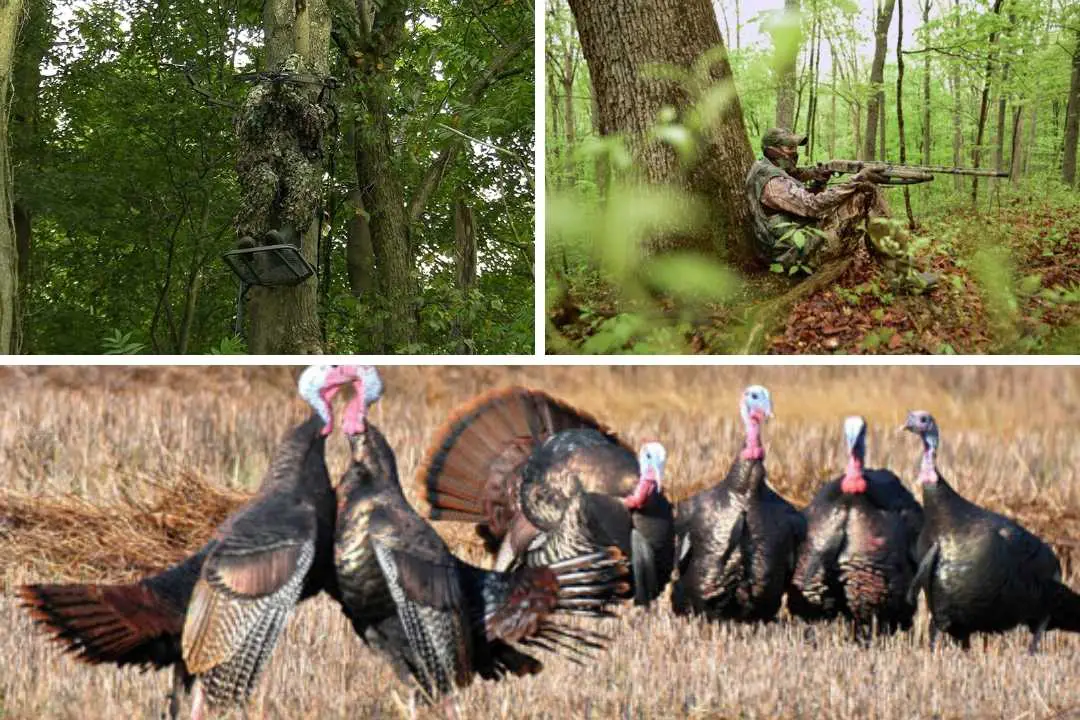
The Foundation: Next-to-Skin Comfort
- Breathable Base Layers: Choose moisture-wicking fabrics that will keep you dry even if you work up a sweat. Merino wool is an excellent option.
- Avoid Cotton: It holds moisture and can lead to chills, especially in cooler mornings.
Mid-Layer Versatility
- Lightweight Fleece or Vest: This provides insulation without bulk, allowing freedom of movement.
- Packable Options: A compressible down or synthetic jacket can be stashed in your pack for unexpected temperature drops.
Outerwear: Rain or Shine
- Waterproof Yet Breathable: Spring showers are common. Look for a jacket with a waterproof membrane that still allows perspiration to escape.
- Camo Considerations: Choose a pattern that blends with your expected hunting terrain, but prioritize function over the latest fad.
Don't Forget Your Feet
- Lightweight, Breathable Socks: Again, avoid cotton. Quality wool or synthetic socks designed for hiking will prevent blisters.
- Boots or Shoes: The choice depends on terrain and your preference. Waterproof boots are often ideal, but lighter hiking shoes can be more comfortable in warmer weather.
Now let's look at those often-overlooked states that offer fantastic spring turkey hunting opportunities, taking you off the well-beaten path.
Where the Spring Action is Hottest: Hidden Gems and Underrated States
Sure, the big-name turkey states get all the attention. But savvy experts know that phenomenal spring action can be found in less crowded, often overlooked destinations. To hunt wild turkeys here's where you need to look:
North is the New South
States further north often have later spring seasons, coinciding with prime gobbling. Consider:
- The Midwest: Missouri, Kansas, Iowa – these states boast strong wild turkey population and ample public land.
- The Northeast: Pennsylvania, New York, and Vermont might surprise you with their challenging terrain and vocal gobblers.
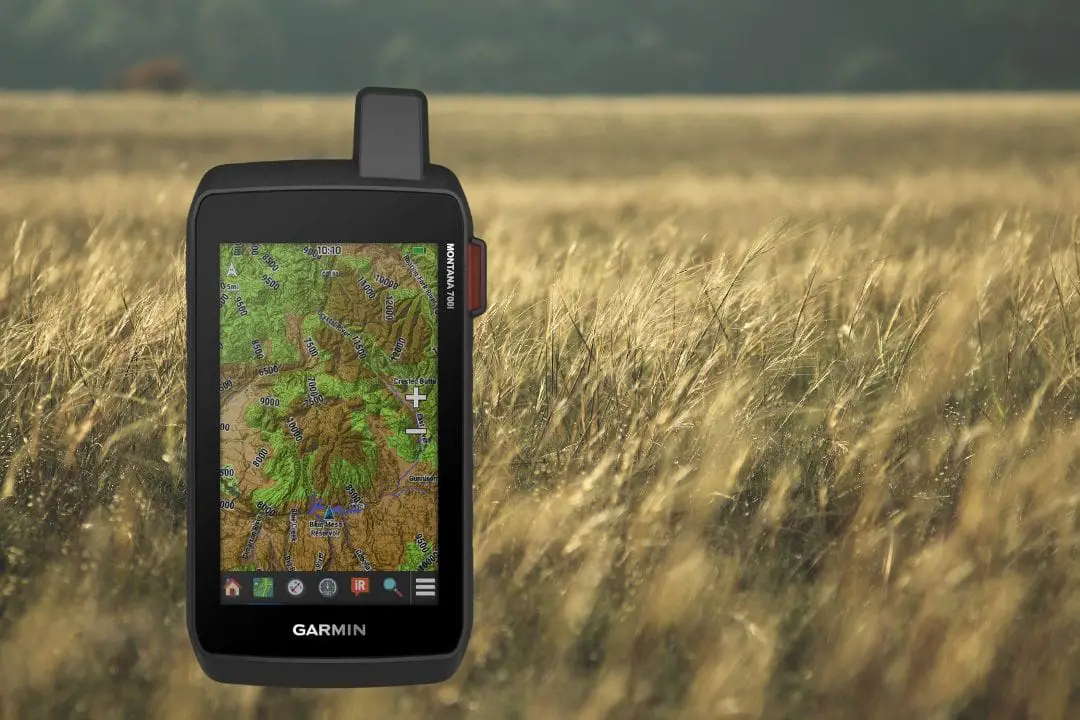
Think West, Not Just East
The western US offers unique terrain and subspecies, adding variety to your spring hunts. Consider:
- Rocky Mountain States: Montana, Wyoming, Idaho – hunt Merriam's turkeys in stunning mountain landscapes.
- The Southwest: Arizona, New Mexico – target Gould's or Merriam's on challenging, wide-open terrain
The Public Land Advantage
States with a significant proportion of public land offer easier access for DIY turkey hunters. Research these:
- The Great Plains: Nebraska, South Dakota, North Dakota – these states might lack dramatic scenery, but they make up for it with ample opportunity.
- The Northwest: Oregon, Washington – while known for big game, these states offer pockets of excellent turkey hunting on national forests and other public lands.
Don't limit yourself to the "usual suspects." Expanding your horizons can lead to unforgettable spring turkey experiences.
Factors to Consider:
- Healthy Turkey Population: This is the foundation. Look for states with abundant wild turkey population and proactive management by wildlife agencies.
- Public Land Access: More public land equals more hunting opportunities, especially for those without private land connections.
- Season Length & Bag Limits: States with longer spring turkey seasons and generous limits provide greater flexibility and reward.
- Subspecies Variation: If you're seeking a specific subspecies (Eastern, Rio Grande, Merriam's, Osceola), consider their distribution.
- Terrain Diversity: From mountains to prairies to dense woods, varied terrain creates diverse hunting challenges and experiences.
Preferred States:
- Missouri: Consistently tops turkey harvest lists, boasts lots of public land, and offers long seasons.
- Kansas: Excellent population density, generous bag limits (especially on public land), and a mix of farmland and rolling hills.
- Nebraska: Overlooked but offers plentiful birds, expansive public land access, and a multi-bird bag limit.
- Wisconsin: Healthy turkey population expanding into new territories, mix of private and public land options.
- Texas: Rio Grande central! Long seasons, generous bag limits, unique terrain, but heavy private-land focus.
Regulations can change from year to year! Always verify the most up-to-date information on your chosen state's wildlife agency website.
Spring Turkey Hunting Tips
- Scout Smarter, Not Harder: Focus your pre-season scouting on identifying strutting zones and the routes gobblers use to travel between them.
- Listen More, Call Less: Spring gobblers are often vocal. Learn to locate birds by their gobbles, then call sparingly and strategically.
- Patience is Your Weapon: A henned-up gobbler can be frustrating. Don't rush. Sometimes the best tactic is to set up, stay put, and wait for the hens to lead him to you.
- Gear for Changing Weather: Spring weather shifts quickly. Layer your clothing and always have rain gear handy.
- Don't Neglect Water: Turkeys need water daily. Hunting near creeks, springs, or even small puddles can be a productive tactic.
- Embrace the Midday: When the morning action dies down, don't give up. Target those shaded midday retreats or water sources.
- The Right Decoy, Right Place: A single hen decoy is often best in early spring. Position it on the edge of a field or opening, not in the center.
- Know When to Hold Back: Aggressive calling can backfire in the spring. If a gobbler seems hesitant, try softer calls or even silence to pique his curiosity.
FAQs for Your First Spring Hunt
You've got the knowledge, now it's time to clear up those common questions that can trip up even experienced hunters during their hunt for spring turkeys.
Q: What's the best time of day to hunt spring turkeys?
A: Mornings are classic time to hunt wild turkey, as gobblers fly down from roosts and are actively gobbling. But don't underestimate midday! Lonesome gobblers or those who've hens to tend to become more responsive to subtle calling.
Q: Does the weather matter in spring?
A: Absolutely! Rain and high winds shut down gobbler activity. Ideal days are calm, clear, and warming up – this gets birds fired up. But don't be afraid to adapt; post-storm hunts can be great as gobblers break their silence.
Q: Should I always hunt strutting zones?
A: Strut zones are magnets, especially early on. But remember, turkeys move! Learn to identify feeding areas, travel routes, and potential midday loafing spots to boost your odds throughout the day.
Q: Can I hunt spring turkeys with a rifle?
A: This varies by state! Many states are shotgun/archery only. Always consult your state wildlife agency's regulations for permitted weapons and any specific restrictions.
Q: Where's the best place to find turkeys on public land?
A: Focus on a mix of terrain. Look for areas with open strutting zones nearby denser woods or thickets (where hens might nest). Water sources and varied food sources attract birds. Pre-scout with maps and put boots on the ground!
Q: How is spring season different from fall turkey seasons?
A: Spring turkeys focus on breeding, not survival like in fall. Gobblers are driven by hens, making calling strategies and predictability shift dramatically. Focus on mastering hen vocalizations and understanding gobbler breeding behavior.
Q: What is the best spring plot for turkeys?
A: Turkeys need food sources easily accessible to open areas for strutting. Clover is a classic choice, providing nutrition and attracting insects. A mix of chufa, grasses, and grains offer variety, extending plot attractiveness.
Q: What is the best state to hunt turkey in spring?
A: There's no single "best," but states with strong turkey populations, generous public land access, and long seasons are ideal. Consider Missouri, Kansas, Wisconsin, Nebraska, and Texas as starting points.
Q: Do turkeys gobble in the spring?
A: Yes! Spring gobbling is intense as toms locate hens, challenge rivals, and advertise availability. Gobbling intensity can vary throughout the day, peaking at dawn and sometimes surging during midday.
Q: Do turkeys breed in the spring?
A: Yes! Spring is turkey mating season. This drives gobbler behavior, making them less focused on feeding patterns than in other seasons and highly responsive to hen-like sounds.
Final Thoughts
The stage is set. You hold the knowledge to unravel the intricate game of spring turkey hunting. It's more than just filling a tag; it's outsmarting a wary gobbler on his own turf, where instinct trumps routine.
The challenge beckons. This isn't about easy hunts or predictable patterns. Success lies in mastering the subtle calls, dissecting gobbler behavior, and embracing the thrill of those heart-pounding, unpredictable encounters.
Gear up (be sure to check out our comprehensive reviews for the best calls, blinds, and more!), then venture forth with the confidence of a seasoned strategist. The spring woods await, promising an adrenaline-fueled test of your woodsmanship unlike any other season.
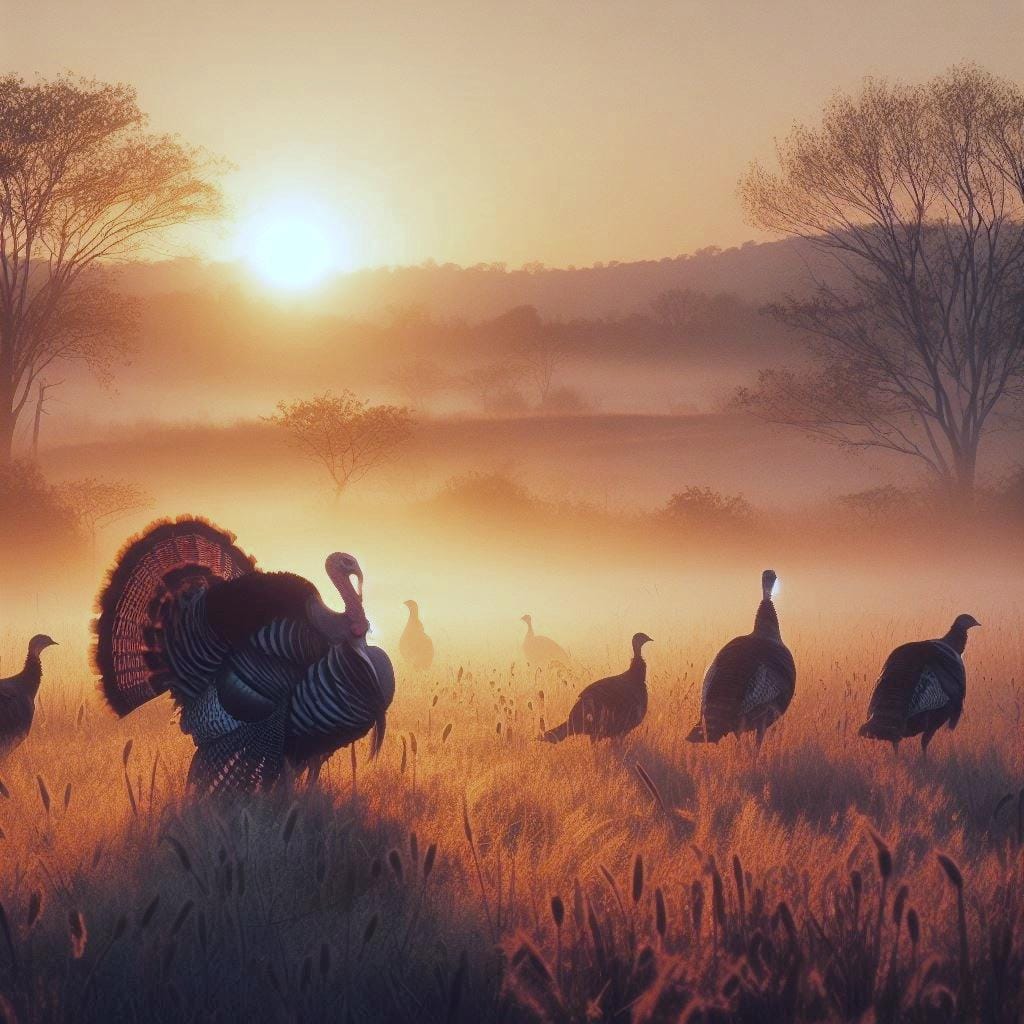
Also, check out our articles on:
